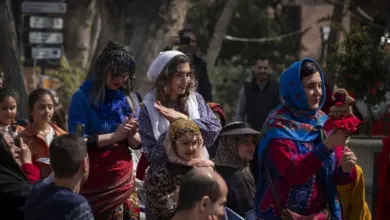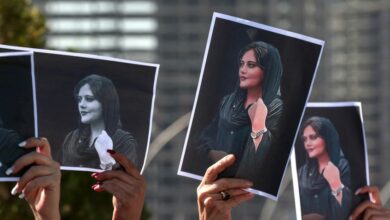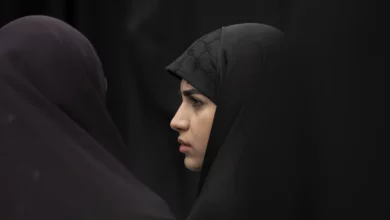This article represents the first part of a series on the question of Islamic radicalism on British campuses
“I’m not angry; I am anger. I’m not dangerous; I am danger,” poet Amir Sulaiman bellowed into the microphone before a Muslim audience of hundreds, including many university students. Some of the audience nodded appreciatively, while others, entranced, seemed to hang on his every word as he spoke of Muslim pain and rage.
He finished his fiery poem to cries of “Allahu Akbar” (“God is Great”) from audience members who congregated in Kensington’s Town Hall to support Cage Prisoners, a Muslim organization that advocates for the rights of prisoners held by the US at Guantanamo Bay and the Bagram military facility in Afghanistan.
The sister (as it is customary to call female Muslims in conservative Islamic circles) who sat next to me during the recital was no more than 20 years old. Shaymaa, a university student, said she had been as moved by the intense poem as she had been by the slide show of Guantanamo Bay Prisoners that preceded it.
One picture showed Omar Khadr, a boy captured at the age of 15 by the US military and sent to Guantanamo. The child was shown lying on the ground, seemingly unconscious, with gaping wounds to his chest and eyes, bleeding from shrapnel. The accompanying caption explained how Omar, and others like him, had grown up in the notorious prison and how some had died there, allegedly due to beatings and torture.
“It’s all so sad,” Shaymaa said. Her reaction mirrored those of many Muslim students her age who have been exposed to similar imagery, including four female City University London students, not much older than she is. When I met them earlier, they told me of the pain they felt for fellow Muslims who, in their words, were suffering from “bigotry and prejudice” in other parts of the world.
Maryam, Sabera, Rabiyya and Rahana are all active members of their university’s Islamic Society (known as City ISOC). Young and vibrant, they spoke passionately about a range of issues, including how much they valued their British upbringing, how their religion was peaceful but “misunderstood,” and how Muslim plight usually went unreported in the mainstream western media.
Outspoken and friendly, they could have been poster children for Muslim social campaigns and pressure groups across Britain. The latter frequently allude to the injustices faced by Muslims when explaining why extremism exists among some young people of the community, and they usually show examples of Muslims who–not unlike these young women–see themselves as British, but who also feel Muslims have been victims of an unsympathetic society, a heavy-handed government and a malicious media.
My investigation into whether or not, as some studies suggest, Islamic societies serve to promote radicalism among their members brought me face-to-face with these City ISOC members who, despite being open about their views, still preferred not to have their last names published–betraying a hint of distrust in journalists, a suspicion perhaps that their words might be taken out of context.
They immediately laughed off the notion that ISOCs foster violent extremism, saying that the university-based groups had done nothing but educate them about the fundamentals of their religion and bring them together with other observant Muslims. “Most of the time we pray, eat and talk,” said Rahana.
The young women blamed right-wing voices and the British media for whipping up fear of Muslim students, especially men with long beards and skullcaps and women wearing headscarves, loose-fitting robes and face veils. They explained how much they valued their traditional dress code, which others often saw as oppressive or confrontational.
Sabera, 20, proudly wears the niqab, which reveals only her eyes, insisting that it had “liberated” her as a woman. She told me that many non-Muslims did not appreciate the niqab and confused it with the burqa, a blue gown that entirely cloaks the wearer’s body from view except for a small net over the eyes.
Sabera explained that what she wears is more comfortable than the burqa. Her niqab has a detatchable face veil that can be removed when eating or drinking or during prayers.
“I felt liberated when I started wearing it,” she told me in City University’s prayer room, the City ISOC’s alternative to a campus mosque. “I feel more confident when I wear it.”
Sabera’s endorsement of the niqab was a far cry from statements made by Daily Mail journalist Liz Jones, who, upon trying the niqab (which she mistakenly referred to as a burqa) last month, said it made her feel like “a dark, depressed alien.”
When told of Jones’ comments, the ISOC members said they were not surprised, insisting that the British media failed to understand the religious reasons for donning the niqab. “It’s such a personal thing. It comes down to your own belief that God is watching you,” said Rahana.
They also dismissed the notion, frequently bandied in the western media, that they had been forced by male Muslims to cover their faces. “No man told me to wear it. No woman told me to wear it,” said Maryam, the recently appointed head sister of the Islamic society. “So who’s oppressing me?”
The young women told me that they had all started wearing the niqab after joining the City ISOC a couple years earlier. “At first it was just a trial,” explained Maryam. “At university, we had a ‘Discover Faith’ week. Quite a few sisters wanted to try the niqab and we tried it out.”
In the beginning it was difficult, she recalled. “But I got used to it within a week. I felt comfortable.”
Now, she never goes out in public without it. When asked if she would ever be willing to remove the face-veil in public, she replied in the negative. “That would be like asking me to go out naked.”
While wearing the hijab is a common practice across the Islamic spectrum, the niqab–and an all-black dress code–is not. The latter, in fact, is generally associated with the ultra-conservative Wahabi and Salafi Islamic ideologies.
Although non-violent, Wahabism and Salafism are both forms of Islamic “separatism,” according to Gillies Kepel, prominent expert on Muslim issues. “Opposed to violence–which they combat relentlessly with Quranic verses, Prophetic sayings and rulings of apostasy–these Salafis nevertheless adhere to a version of Islam that imposes complete cultural separation from the West,” Gillies writes.
This ideology might not be strongly reflected in the individual opinions of these young City ISOC members, who, apart from the way they dress, strike up friendships with non-Muslim colleagues with whom they pursue similar lifestyles. Rahana, for instance, said her main hobby was “shopping with friends on Oxford street,” while Maryam admitted a weakness for video games. All four young women said they hoped to pursue careers in the UK after graduating from university. “Britain is the only home I know,” said Maryam.
What’s more, most of ISOC’s female members wear the Hijab, not the niqab. Nevertheless, the latter is often regarded as “the model” dress code, even among those who do not wear it.
The niqab is related to other core Salafi and Wahabi values, such as forbidding women from mixing with males that are not blood relatives or husbands. These values have led many young Muslim women like Maryam and her friends to self-segregate–a practice encouraged at ISOC events.
When I tried to get male and female members of the society in one room for a discussion of these issues, a former head sister of the City ISOC informed me that this would be “impossible.” Attempts to meet seperately with the brothers, meanwhile, proved equally unsuccessful.
Part 2 of this serieson the issue of Islamic radicalism on British campuseswill appear next week




